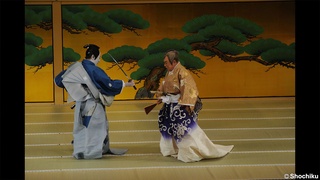
LIVE
The World of Chushingura: The Treasury of Loyal Retainers (Part 1)
KABUKI KOOL
Chushingura is one of the most popular plays. It is based on a sensational historical incident when 47 masterless samurai avenged the death of their lord. Ainosuke explores it in a two-part series.
Watch Live
Donald Keene與三島由紀夫
三島在1957年因Donald Keene英譯的五齣"近代能樂集"
- 三島由紀夫, Five Modern Noh Plays - Including: Madame de Sade (Tuttle, 1954)
演出,訪美半年。
在五位近代 日本小說家中談三島之戲劇佳作,多為六零年代作品。
另外在二十一世紀出版三島給他的書信。
交友関係[編集]
日本文壇[編集]
- 三島由紀夫
- 1954年に知り合って以来[106]、親交を重ねた[注釈 35]。ドナルド・キーンの当て字「怒鳴門鬼韻」は文通時に三島が書いて送ったものである[109]。三島事件で三島が死亡したときには日本への渡航を調整し、自らの『仮名手本忠臣蔵』の翻訳本を祭壇に供えた。当初キーンは弔辞を読むことも引き受けたが、三島の右翼思想を擁護しているように捉えられるとの友人らの説得により葬式には出席せず、そのことを後に何度も悔やんだと著書で述べている[107]。2015年のインタビューで「(三島の)自死の理由は、いまもわかりません」と答えている[108]。キーンは誠己に対し、「天才はそんなにいるものではありません。僕の知っている天才はウェイリー先生と三島由紀夫さんだけです」と語っている[110]。
《忠臣藏》(參考:台北南天書店近年出版品)
英譯是三島由紀夫生前託Donald Keene的......
- Chushingura(忠臣蔵 英文論文集副標題 Studies in Kabuki and the Puppet Theater,Keene 寫第一篇,頁1~21 Variations on a Theme: ~): The Treasury of Loyal Retainers, a Puppet Play (Columbia Univ Pr, April 1, 1971) 翻譯
共著者 徳岡孝夫『悼友紀行―三島由紀夫の作品風土』中央公論社、東京、1973年。ISBN 4-12-200876-X。OCLC 19475548。
- 三島由紀夫, After the Banquet (Random House Inc, January 1, 1973) 待查
友誼
日本文壇
三島由紀夫
自1954年相識以來,[106]他們一直是親密的朋友。[註35] 當他們通信時,三島寫下並發送了唐納德·基恩的暱稱“Yōmon Kion”。[109] 三島在三島事件中去世後,他安排他前往日本,並將他翻譯的《忠臣藏》供奉在祭壇上。 基恩最初同意宣讀悼詞,但他的朋友們勸他不要參加葬禮,因為他們擔心這會被視為捍衛三島由紀夫的右翼意識形態,後來他在書中多次對此表示遺憾[107 ]。 在 2015 年的一次訪談中,他說,「我仍然不知道(三島)自殺的原因。」[108] 基恩對誠說:「天才不多。我認識的天才只有韋利和三島由紀夫。」[110]
****
漫談"Donald Keene 譯/著的日本文學" 26:
午後の曳航, romanized: Gogo no eiko, 三島由紀夫說漢字之重要;美;標題/雙關語難譯。Furi-kana/Furigana (振り仮名, yomigana (読み仮名) and rubi (ルビ) "yatsuhashi"
The Sailor Who Fell from Grace with the Sea
Wikipedia
https://en.wikipedia.org › wiki › The_Sailor_Who_F...
The Sailor Who Fell from Grace with the Sea (Japanese: 午後の曳航, romanized: Gogo no eiko, lit. 'Afternoon tow') is a novel written by Yukio Mishima ...
"The Japanese title couldn't be translated well," said the novelist三島由紀夫, ..."In Japanese the book is called 'Gogo No Eiko,' which literally means 'Afternoon's Tow,' referring to a tugboat taking a ship through a harbor. 'Eiko' is a play on words: It means either 'tow' or 'glory.'
"Romaji is awful," Mr. Mishima said flatly. "The visual effect of a Chinese character is very important." He slashed out the rounded, multi-stemmed character for "rose," and looked at it admiringly. "See how the rose appears physically in the shape of the Kanji," he said. "A writer loves to give such an effect to his readers."
"but I don't mind small mistakes." He was amused, not angry, when the translator of an earlier novel rendered the word "yatsuhashi" as "eighth bridge,
八つ橋
Yatsuhashi baked cinnamon mochi - Japan Centre
八橋" which is a perfectly correct alternate reading of the characters that the author intended to mean a kind of cake sold in Kyoto. "The translator really had to struggle with that sentence to have it make sense with a bridge in it," he said, chuckling.
September19, 1965 NYT
How to Write in Japanese
By ROBERT TRUMBULL
Mr. Trumbull heads The Times Tokyo bureau.
Furi-kana。我們也使用 Hira-gana,它總是用於外來語。”
Furigana (振り仮名, Japanese pronunciation: [ɸɯɾigaꜜna] or [ɸɯɾigana]) is a Japanese reading aid consisting of smaller kana (syllabic characters) printed either above or next to kanji (logographic characters) or other characters to indicate their pronunciation. It is one type of ruby text. Furigana is also known as yomigana (読み仮名) and rubi (ルビ, [ɾɯꜜbi]) in Japanese. In modern Japanese, it is usually used to gloss rare kanji, to clarify rare, nonstandard or ambiguous kanji readings, or in children's or learners' materials. Before the post-World War II script reforms, it was more widespread.[1]





沒有留言:
張貼留言